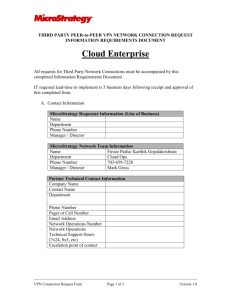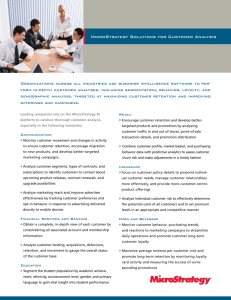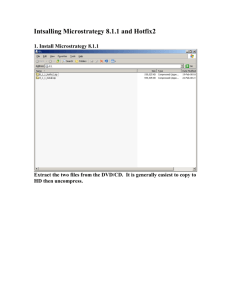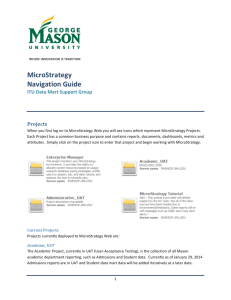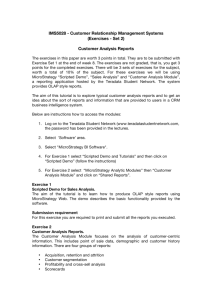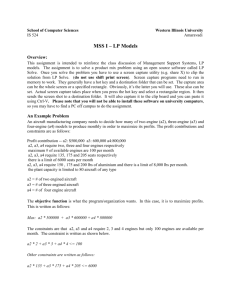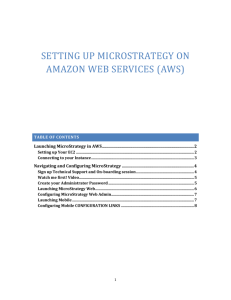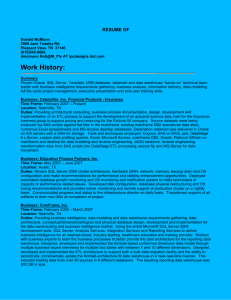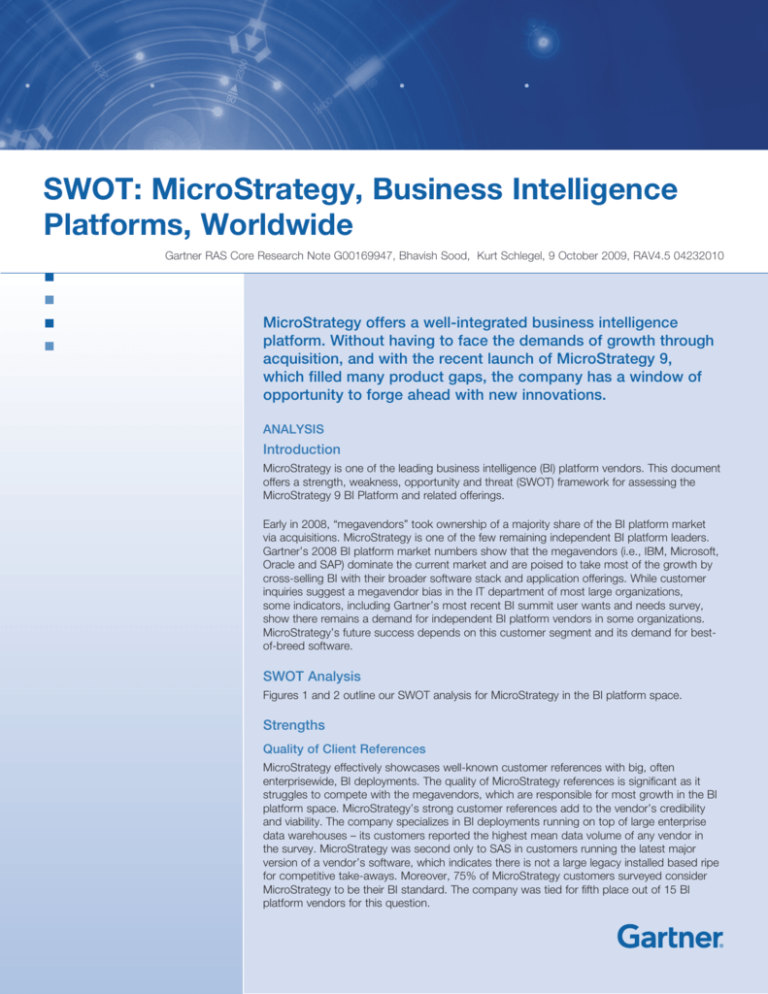
SWOT: MicroStrategy, Business Intelligence
Platforms, Worldwide
Gartner RAS Core Research Note G00169947, Bhavish Sood, Kurt Schlegel, 9 October 2009, RAV4.5 04232010
MicroStrategy offers a well-integrated business intelligence
platform. Without having to face the demands of growth through
acquisition, and with the recent launch of MicroStrategy 9,
which filled many product gaps, the company has a window of
opportunity to forge ahead with new innovations.
ANALYSIS
Introduction
MicroStrategy is one of the leading business intelligence (BI) platform vendors. This document
offers a strength, weakness, opportunity and threat (SWOT) framework for assessing the
MicroStrategy 9 BI Platform and related offerings.
Early in 2008, “megavendors” took ownership of a majority share of the BI platform market
via acquisitions. MicroStrategy is one of the few remaining independent BI platform leaders.
Gartner’s 2008 BI platform market numbers show that the megavendors (i.e., IBM, Microsoft,
Oracle and SAP) dominate the current market and are poised to take most of the growth by
cross-selling BI with their broader software stack and application offerings. While customer
inquiries suggest a megavendor bias in the IT department of most large organizations,
some indicators, including Gartner’s most recent BI summit user wants and needs survey,
show there remains a demand for independent BI platform vendors in some organizations.
MicroStrategy’s future success depends on this customer segment and its demand for bestof-breed software.
SWOT Analysis
Figures 1 and 2 outline our SWOT analysis for MicroStrategy in the BI platform space.
Strengths
Quality of Client References
MicroStrategy effectively showcases well-known customer references with big, often
enterprisewide, BI deployments. The quality of MicroStrategy references is significant as it
struggles to compete with the megavendors, which are responsible for most growth in the BI
platform space. MicroStrategy’s strong customer references add to the vendor’s credibility
and viability. The company specializes in BI deployments running on top of large enterprise
data warehouses – its customers reported the highest mean data volume of any vendor in
the survey. MicroStrategy was second only to SAS in customers running the latest major
version of a vendor’s software, which indicates there is not a large legacy installed based ripe
for competitive take-aways. Moreover, 75% of MicroStrategy customers surveyed consider
MicroStrategy to be their BI standard. The company was tied for fifth place out of 15 BI
platform vendors for this question.
2
Launch of MicroStrategy 9
MicroStrategy offers a well-integrated BI
platform with a common metadata layer
and infrastructure, as well as a unified user
experience. Because it does not have to face
the demands of growth through acquisition,
MicroStrategy is not bogged down by the
same integration challenges, overhead and
complex operating environments of the
megavendors. Consequently, MicroStrategy
has a window of opportunity to forge ahead
with innovation. A major positive development
has been the launch of MicroStrategy 9,
which is a major release since MicroStrategy
8 in February 2005 (although there have
been a number of releases during this
period, including new administrative tools,
a mobile offering and support for leading
third-party products, such as portals).
Crucial enhancements include new enduser functionality, such as report design and
report interactivity features (such as “smart
placement assistants” and multiselect drilling
Figure 1. Graphical Representation of SWOT: MicroStrategy, BI Platforms,
Worldwide
Source: Gartner (August 2009)
Figure 2. SWOT: MicroStrategy, BI Platforms, Worldwide
Strengths
• Quality of client references
• Launch of MicroStrategy 9
• Innovation in Mobile BI
• Lower administration cost paradigm
• Strong customer support
• Product strengths
Opportunities
Weaknesses
• Challenges associated with organic growth in a
consolidating market
• Dependence on big deals to grow
• Low market share in emerging markets
• High learning curve for end users and
developers
• Lack of performance management capabilities
of its own
Threats
• "Outintegrate" the stack vendors
• History of complex and strict licensing
• Add functionality from ancillary markets
• Improving data performance undermines
differentiation
• Attacking the midmarket
• Improve go-to-market opportunities with more
OEM deals
• The rise of data discovery tools
• Reliance on professional services
• Economic downturn
Source: Gartner (August 2009)
© 2009 Gartner, Inc. and/or its Affiliates. All Rights Reserved. Reproduction and distribution of this publication in any form without prior written permission
is forbidden. The information contained herein has been obtained from sources believed to be reliable. Gartner disclaims all warranties as to the accuracy,
completeness or adequacy of such information. Although Gartner’s research may discuss legal issues related to the information technology business, Gartner
does not provide legal advice or services and its research should not be construed or used as such. Gartner shall have no liability for errors, omissions or
inadequacies in the information contained herein or for interpretations thereof. The opinions expressed herein are subject to change without notice.
3
and filtering on any report object), the multisource option in which
report developers have access to multiple data sources in a project,
improved visualization and in-memory analytic capabilities, support
for federated querying to support operational reporting, and the
availability of the full-function free reporting suite. A combination
of product-level enhancements and MicroStrategy’s messaging
around heterogeneity and independence should help its licensing
business, which has been declining in the last two years. Initial
discussions with MicroStrategy show there has been uptake on the
platform in some accounts, along with some planned migrations as
version 9.01 becomes generally available. As of August 2009, more
than two-thirds of all MicroStrategy customers had requested and
received a license key for MicroStrategy 9.0.
Innovation in Mobile BI
The next wave of platform consolidation around BI will probably
be led by BI platform extensions for mobile devices. Mobile BI is
just emerging as a market segment, but the ubiquity of handheld
devices lays a strong foundation for disseminating information from
BI systems to mobile clients. Consistent with its product strategy
of doing everything organically, MicroStrategy has built its own
middleware layer that allows clients to optimize low device memory
resources, as well as rendering reports on BlackBerry mobile
devices based on the device model, screen resolution and browser
interface. The mobile product is full-function, allowing clients to do
report manipulation, such as page by, sort, pivot or hide columns.
Additionally it allows for remote administration and installation of the
client through the BlackBerry Enterprise Server, ensuring security
and control in a corporate IT environment.
Another innovation MicroStrategy recently launched was around the
availability of its reports and dashboards through e-mail or Universal
Serial Bus on the Amazon Kindle DX, which is an e-book reader
with a larger screen helpful for viewing reports and documents,
with some additional capabilities. Amazon provides a service
whereby documents can be delivered wirelessly to the device via its
Whispernet service. Whispernet is a data service provided by Sprint
via a cellular wireless connection. Currently, this service is available
only in the U.S.
Lower Administration Cost Paradigm
MicroStrategy has one of the lowest requirements for IT support
staff, as evidenced by responses Gartner received as part of its
BI Magic Quadrant Customer Reference Survey. There are two
reasons for this.
The first is due to MicroStrategy’s typical report paradigm of
delivering highly parameterized reports using report builders. In
this way, IT can build one report that a report consumer can
“customize” into numerous different reports, versus having to
create them via a static report model.
The second reason is that MicroStrategy’s integrated code base
tends to be more stable than that of its megavendor competitors.
This makes migrations and upgrades more seamless. In fact,
MicroStrategy customers indicated they had the best migration
experience across all BI vendors in the survey, with 95% of
MicroStrategy customers saying that their migration to the
latest version was “straightforward and of little cost”. Moreover,
MicroStrategy was designed for centralized management in which
a small number of administrators can support big BI projects with
many users, complex reporting and analysis requirements, and a
large amount of data. Recent enhancements also improve support
and administration costs. For example, Integrity Manager helps
with migration and change management scenarios to ensure that
objects are all functioning correctly after a major development
effort in the MicroStrategy environment. This complements
MicroStrategy’s already-strong reputation for delivering reliable
code.
The survey results shown in Figures 3 and 4 are based on
the 480 responses Gartner received as part of its BI Magic
Quadrant Customer Reference Survey. Notice how, in Figure 4,
MicroStrategy’s bubble is much smaller, indicating fewer required
administrators, even though it is positioned far to the right on data
volume and relatively high for the mean number of users.
Strong Customer Support
MicroStrategy customers rated the company’s support as one
of the highest in vendor support. MicroStrategy had the secondhighest rating after Spotfire out of 15 vendors surveyed.
A big reason MicroStrategy offers strong customer support is
the fact that its technical support engineers need to support only
a single platform with a single underlying code base regardless
of BI style or interoperability requirements, such as operating
system or database management system. Additionally a majority
of MicroStrategy customers (86% of MicroStrategy customers
surveyed) run the latest MicroStrategy software, further reducing
the number of product versions that technical support engineers
need to support.
The survey results indicate that smaller BI platform vendors
deliver better technical support than larger ones in general and
megavendors in particular.
Product Strengths
MicroStrategy offers a well-integrated BI platform with a common
metadata layer and infrastructure and a unified user experience
in an attempt to uniquely ensure that the full range of product
functionality is available across the entire product set via a
consistent look and feel. MicroStrategy 9 is a major development
release since MicroStrategy 8, and it has filled product gaps. New
features include the ability to query multiple data sources and to
more fully leverage its 64-bit architecture by taking advantage
of the larger addressable memory space to deliver a flexible
in-memory cache.
From a product perspective, MicroStrategy 9 delivers “above
average” functionality, across all BI platform components, in
nine of 12 BI platform capabilities (all except for workflow and
collaboration capability, in which it was lower, and office integration
and data mining, in which it did not garner a sufficient number
of customer responses from the customers initially surveyed),
with strong capabilities in metadata management, dashboards,
BI infrastructure, development environment, online analytical
processing (OLAP), advanced visualization and scorecarding. This
indicates the company’s completeness of vision and ability to meet
customer requirements.
4
Figure 3. Migration Experience
MicroStrategy
Straightforward
and of little cost
Board
Tibco Spotfire
Straightforward but
costly
JasperSoft
Panorama
Complex and
costly
QlikTech
arcplan
Very complex and
very costly
Information Builders
IBM Cognos
Microsoft
SAS
SAP
Oracle
0
20
40
60
80
100
Percentage of Respondents
N = 295
Notes: Chart represents survey results and not Gartner’s opinion.
Includes only those vendors with 10 or more responses.
Source: Gartner (August 2009)
Figure 4. Users, Data and Administrators
6500
Actuate
5500
End Users, Mean
4500
SAP Business Objects
3500
2500
1500
500
Mic roStrategy
Oracle
Tibco
Spotfire
Information
Builders
arcplan
-250 -500
250
SAP
Panorama
750
1,250
Data, Mean (Gigabytes)
Notes: Bubble size represents mean number of administrator staff, ranging
from 2.6 (Tibco Spotfire) to 11.9 (Microsoft).
Includes only vendors with 10 or more responses.
Source: Gartner (August 2009)
Microsoft
SAS
Jas perSoft
Board
IBM Cognos
1,750
2,250
5
While MicroStrategy offers best-of-breed functionality and an
integrated end-user experience across most BI platform functional
areas, interactive reporting is the MicroStrategy “sweet spot.”
MicroStrategy’s reporting capability scored at the top of all vendors
included in the survey for five of the 10 critical reporting capabilities
(ease of use for developers, data volume scalability, complex
interactive reporting, sophisticated SQL support and high-quality
portable output.
Key strengths of its product strategy are shown in Table 1.
Table 1. MicroStrategy’s Product Strategies
Comments
Reporting
MicroStrategy offers a robust and flexible object-oriented report development environment
for creating reports, with high degrees of formatting and analytic complexity. Business users
from the Web can create reports via a guided workflow or by dragging and dropping business
metadata (i.e., attributes and metrics) onto a formatted or free-form template for WYSIWYG
layout. Users can apply further “pixel level” formatting via Office-like controls.
Ad Hoc Reporting and Analysis
In particular, MicroStrategy’s use of multipass SQL enables users to dynamically create
complex ad hoc reports. In addition, MicroStrategy’s ROLAP architecture enables a wide
array of analytical capabilities, such as cross-tabs, page by, multikey sort, drilling, ranking, and
sorting across relational and OLAP data sources.
MicroStrategy also delivers ad hoc interactivity to end users through one of the more extensive
set prompting and filtering options of any reporting tool, save Information Builders, including
Object (what metric), Attribute (what attribute), Value (“what if”), Hierarchical (filter based on
hierarchies), Cascading, Column (what appears on the report) and Metric Qualification (filter
based on rank), as well as dynamic dates and prompts (for example, rolling date filters). Of
the vendors we looked at, only MicroStrategy and Information Builders enabled the user
to switch the dimension or measure at runtime via prompts. The other vendors offered
prompted reporting, but only to drill within a particular dimension. This extensive prompting or
parameterization support improves report creation and modification for casual users.
Office Integration
MicroStrategy Office is an additional add-on product that enables Microsoft Office to become
a full MicroStrategy client. Reports can be created, opened, modified and refreshed in Excel.
MicroStrategy can save formatting and other aspects of the underlying report back to the
MicroStrategy metadata repository and provides support for document formats, formulas, data
“refresh” and pivot tables. Additionally, MicroStrategy provides interactive offline functionality,
custom visualization via Flash rendering and a variety of display options – grid, graph, pivot
table, pivot chart, Flash, list, images, documents, PDF, comma-separated values, etc. Writeback is possible but requires an SDK customization.
OLAP
MicroStrategy is well-known for its ROLAP architecture, but it does have an OLAP offering for
more-predictable query performance against well-known queries. While it fixed the issue of
write-back in MicroStrategy 9, it still lacks the “what if” scenario modeling capabilities of moretraditional OLAP products. MicroStrategy 9’s in-memory ROLAP is an architectural extension
of version 8’s ROLAP, in which physical ROLAP cubes now reside in-memory within the global
virtual cube. The ROLAP cubes contain selected components of potentially large amounts
of data and fit into the global virtual cube, ensuring all 64-bit-based OLAP operations and
analysis perform significantly faster than in version 8.
Dashboards
MicroStrategy dashboards stand out among traditional BI platform vendors since they
embrace both Ajax and Flash clients to provide a choice of rich interactive visualization
experiences. As of MicroStrategy 9, the Ajax dashboards are fully drillable within or across
any dimension as desired. There were also compression enhancements to the Flash-based
databases in MicroStrategy 9 to allow for analysis of larger datasets with good performance.
(continued on page 6)
6
Table 1. MicroStrategy’s Product Strategies (continued)
Scorecard
MicroStrategy scorecarding has the ability to design strategy maps using methodologies
such as the balanced scorecard and has the ability to generate cubes from the scorecard
model for further analysis. However, metric status alerting in the case of a metric change
requires customization. Setting thresholds for a visual alert was available in MicroStrategy
8 but could be created only by a desktop user. In MicroStrategy 9, Web users can create
metric change conditions (i.e., absolute or percent/relative value changes) for alerting
conditions to occur. Still missing is the automated workflow synchronization of users to
metrics, which must be customized.
Predictive Modeling and Data
Mining
While its offerings in this area are not widely adopted, MicroStrategy does have extensive
capabilities in predictive modeling and data mining. MicroStrategy can create and score
data mining and predictive models, as well as import models from third-party data mining
tools via PMML (an XML standard to describe data mining models). This data mining
service module is part of the core (i.e., no extra cost) platform. MicroStrategy supports three
approaches to integrating data mining with mainstream BI. First, it allows users to develop
their own predictive models without requiring a dedicated data mining tool. MicroStrategy’s
model creation engine supports some of the more commonly requested data mining
algorithms, including linear, tree and logistic regression, clustering, decision trees, time
series, and association rules. Second, for those customers who already have or need a data
mining tool, such as SAS, SPSS, KXEN, Angoss or Zementis, among others, MicroStrategy
can import their models via PMML into predictive metrics that are fully integrated into
the MicroStrategy metadata. This allows MicroStrategy to score models (such as neural
networks, rule sets and vector machines) and ensembles of models and make the result,
a score or a probability easily available to users and usable in other objects, such as filters,
custom groups, prompts, thresholds and other metrics. Third, the MicroStrategy SQL
Engine can pass advanced analytics, such as set analysis or multicolumn hypothesis testing
functions (such as chi-square test or F-test) to the database.
Metadata Management
MicroStrategy has a strong object-oriented metadata environment in which developers can
centrally define data abstraction objects (e.g., attributes, facts and hierarchies) and report
layout objects (e.g., custom groupings, filters and prompts) one time. Business users use
these reporting objects to build any type of report or analysis. Reporting objects can be
embedded into any number of levels, such as a data filter that is embedded in a prompt,
which is in turn embedded in a calculation, ensuring maximum report object reusability and
a single version of the truth. Changes made to the metadata model will be inherited to all
the downstream reporting objects and reports.
PMML = Predictive Model Markup Language
ROLAP = relational online analytical processing
SDK = software development kit
WYSIWYG = what you see is what you get
Source: Gartner (August 2009)
Weaknesses
Challenges Associated With Organic Growth in a
Consolidating Market
Major consolidation occurred within the BI industry in 2007. SAP
acquired Business Objects, IBM acquired Cognos, and Oracle
bought Hyperion. Megavendors discovered a nice revenue stream
by having large BI offerings in their portfolios. These vendors
expect to grow product license revenue with their marketing and
sales muscle. Additionally, these vendors are looking to benefit
from the maintenance fees these large acquisitions bring with
their installed bases. As a result, the market is now dominated by
megavendors; in 2008, they accounted for 63% of the market, with
MicroStrategy’s share remaining constant at 5% (see Figure 5).
MicroStrategy’s growth will be hampered by three trends:
• Megavendors (such as SAP, Oracle and Microsoft) are
embedding analytics directly into workflows and processes,
from both an application and middleware perspective.
• MicroStrategy will continually struggle to show tangible
differentiation of its best-of-breed products as the megavendors
(and other competitors) slowly improve their product offerings.
• In some cases, MicroStrategy will be competing against
a megavendor, particularly Microsoft, where the customer
has already purchased an enterprise license agreement and
therefore has product use rights on the BI capabilities.
7
Figure 5. BI Platform Market Share, Worldwide, 2007 and 2008
2007
12%
2%
4%
2008
2%
2%
3%
19%
11%
26%
5%
5%
5%
15%
7%
11%
14%
7%
10%
Business Objects
Cognos
Hyperion
MicroStrategy
Information Builders
Others
14%
SAS Institute
Microsoft
SAP
Oracle
Actuate
13%
13%
SAP
Microsoft
Oracle
SAS Institute
IBM
MicroStrategy
Information Builders
QlikTech
Actuate
Others
Source: Gartner (August 2009)
MicroStrategy is trying to manage these challenges with version
9 in which migration from small departmental (new customer)
deployments is made easier to capture new customers. However, it
remains to be seen how efficient this will be.
Dependence on Big Deals to Grow
MicroStrategy’s sweet spot has been at the high end for complex
analytical reporting and other technical requirements, as well as in
clients that require large data scalability and have a higher number
of business users accessing data. However, MicroStrategy has
already penetrated many of these big deals. Consider the following:
• MicroStrategy has been showing license declines since 2007,
which is when the consolidation of BI vendors occurred in the
industry.
• As per the company’s Securities and Exchange Commission
(SEC) filings in 2008, MicroStrategy had only one large deal of
more than $4 million in license revenue.
work against large datasets. As a result, MicroStrategy’s ability to
penetrate these markets will clearly depend on the success of its
full-function free reporting suite that the company launched earlier
this year. So far, interest in MicroStrategy’s free offerings has been
modest. According to the company, MicroStrategy Reporting Suite
has had more than 1,000 activations in the six-month period April
through September 2009, with significant activity in Asia/Pacific.
While it continues to show reasonable growth in important
emerging regions (see Table 2), MicroStrategy’s share of the overall
BI platform market in these regions remains small. Additionally,
its appeal is particularly relevant to sophisticated “power users” in
industries such as retail, financial services, and telecommunications.
MicroStrategy has recently had great penetration into the Internet
search and commerce space, given the sector’s enterprise-class
BI requirements, such as very large data volumes, high concurrent
user counts, very fast performance at scale and support for
extranet deployments.
Table 2. MicroStrategy BI Platform Market Share by Emerging
Region, 2006-2008 (Percent)
• There’s a year-over-year decline in license revenue in both U.S.
domestic and international markets (see Figure 6).
Software support service and update revenue is what’s driving
growth (see Figure 7). However, a year-over-year decline in
licensing revenue will hamper this growth at some point.
Low Market Share in Emerging Markets
Many emerging markets still do not have large amounts of digital
data to justify investments in a BI platform that is optimized to
2006
2007
2008
Growth
Eastern Europe
0.6
0.6
1.2
110.5
Latin America
2.0
2.3
2.2
0.7
Asia/Pacific
4.0
4.0
5.2
36.8
Source: Gartner (August 2009)
8
Figure 6. MicroStrategy Revenue Growth, 2005-2008
Grow th (Percent)
50
43.86
40
30
20
16.51
22.69
10
11.12
5.47
3.02
11.70
11.70
7.46
0
-6.56
-1.49
-4.40
-10
2005
2006
New Licens e Revenue
2007
Software Support Services and Updates
2008
Professional Services Revenue
Source: Gartner (August 2009)
Figure 7. MicroStrategy New License and Software Support Service and Update Revenue, 2005-2008
Millions of Dollars
200
184.03
180
165.61
160
142.14
140
120
100
115.85
99.93
107.38
100.34
95.92
80
60
40
20
0
2005
2006
New Licenses
2007
Software Support Services and Updates
Source: Company SEC filings and Gartner estimates (August 2009)
2008
9
High Learning Curve for End Users and Developers
MicroStrategy has had a reputation for being a complex BI platform
with a high learning curve for developers and power users. Part
of the reason for the steep learning curve is that MicroStrategy is
a sophisticated tool designed to handle the most-challenging BI
reporting and analysis requirements at scale. It is a very robust;
object-oriented platform with extensive SDKs that may be used
by developers to support any level of BI application complexity.
The developer environment offers a number of productivityenhancing features and out-of-the-box objects, but it is indeed
a developer tool beyond the capabilities of the average casual
user. MicroStrategy 9 has improved usability, particularly in its
Web interface. For example, end users can now create and
fully format a far greater number of graph types from the Web.
However, MicroStrategy 9 still follows the development paradigm
of creating individual report objects, such as tables and charts on
either the Web or desktop and then combines these objects into
documents and dashboards using another tool, Report Services.
Users often complain that this multitool development paradigm is
a cumbersome workflow. MicroStrategy recommends customers
deploy MicroStrategy dashboards and MicroStrategy Web with
parameterized prompts for casual users.
In addition, its robust architecture requires sophisticated
development, particularly in the complexity of the metadata
models required for MicroStrategy projects; although the average
MicroStrategy application metadata make take longer to build
initially, there are significant savings over the life of the application,
given the significant reuse opportunity, which makes subsequent
end-user report creation far easier. MicroStrategy is making efforts
to show a quicker time to value. Training sessions are focused
on how quickly a project can be created. This works for simple
requirements, but more-complex reporting requires a complex yet
flexible (and functionally complete) metadata model that takes time
to create and depends on having the underlying data warehouse
modeled with the right data.
Lack of Performance Management Capabilities of Its
Own
MicroStrategy competes in a market in which megavendors offer
end-to-end BI, corporate performance management (CPM),
packaged analytic applications, and integration middleware
optimized for their specific enterprise applications and technology
stacks. Discussions with Gartner clients regarding BI have revealed
an increased focus on performance management. This increased
focus has been driven by the need for BI initiatives that enable
organizations to measure, manage and optimize performance to
achieve efficiency and financial benefit, rather than simply analyzing
past performance using traditional OLAP-style tools. Increasingly,
CPM applications can be used to identify the drivers of profitability
to help organizations pursue profitable revenue growth.
In the past, MicroStrategy has partnered with Longview’s CPM
Suite with limited success and now has a technology partnership
with Carpio. Carpio’s GesFin CPM Suite for MicroStrategy is a
fully integrated CPM application, making it a seamless plug-in to
MicroStrategy that can be added as another project available in
the MicroStrategy user portal. GesFin uses single sign-on from
MicroStrategy with a unified look and feel so the user never has
to leave the MicroStrategy environment to perform CPM or any
related reporting functions. From users’ perspective, they never
leave MicroStrategy or know they are using a third-party CPM
application. Gartner believes that selling the CPM applications of a
third-party vendor will put additional strain on MicroStrategy’s sales
force since CPM solutions are usually sold to the office of the CFO
and not the CIO.
Gartner believes MicroStrategy should not try to compete in the
CPM suite market, particularly after Microsoft so abruptly left
the market after a two-year effort. MicroStrategy should instead
focus on delivering a best-of-breed BI platform for reporting and
analysis that integrates well with all CPM suites. However, the
company’s lack of CPM capabilities of its own is a weakness.
MicroStrategy’s focus on BI platforms may increasingly exclude
it from consideration, particularly in enterprise BI standardization
projects that are closely tied to CPM requirements.
Opportunities
“Outintegrate” the Stack Vendors
Too many organizations confuse single-vendor sourcing with
integration. Subscribers to this “stack centric” approach believe
that, if a single vendor sources the majority of their software
architecture stack, then the burden of integrating that stack will be
largely placed on the vendor instead of their internal IT organization.
This theory suffers from two serious flaws.
First, with few exceptions, SAP, Oracle and IBM have acquired
multiple third-party vendors for extraction, transformation and
loading (ETL), data quality, reporting, analysis, planning, and
budgeting. Integrating these disparate code bases together, along
with their broader software stack (e.g., application server, portal
and database), is a monumental task that will take three to five
years and may never be truly accomplished. Bundling together
packaged but loosely integrated solutions is a more likely outcome.
Second, as hard as it may try, it is virtually impossible for a
large organization to standardize on a single vendor’s complete
stack. There will always be divisions still running nonstandard
components. Even if a company is mostly integrated with software
from a single vendor, it may merge or acquire another company
running nonstandard software. Moreover, interoperability with
nonstandard software run by customers and partners will be
increasingly required.
These two flaws present an opportunity for MicroStrategy to
provide the best overall BI platform integration across all four
megavendors’ software stacks. MicroStrategy faces the same
challenge mentioned in the first flaw, but it has a significant
head start. For years, the company has positioned itself as an
independent that relies on, integrates with and optimizes other
vendors’ enterprise portals, databases and application servers. As
for the second flaw, MicroStrategy is one of the few vendors trying
to make its reporting and analysis software equally support all the
leading data integration and CPM suites on the market.
The major caveat to this market opportunity is that the majority of
large organizations subscribe to the single-vendor-supplier strategy.
So this is only an opportunity for MicroStrategy in terms of the
10
minority of companies that realize the flaws of the stack-centric
approach.
Add Functionality From Ancillary Markets
MicroStrategy should not enter the ancillary markets of data
integration and CPM suites. Entering them would eliminate the
stack integration opportunity. Also, consider how Microsoft dabbled
in but eventually exited the CPM suite market. Even Microsoft didn’t
believe, with all its marketing muscle, that it could make enough
money in the market fast enough to justify losing focus on its
“cash cows,” such as SQL Server and SharePoint. MicroStrategy’s
thresholds for growth may be smaller than Microsoft’s, but entering
ancillary markets would have been even more problematic for
MicroStrategy – a company that prides itself on providing best-ofbreed, quality software.
However, adding certain capabilities from these ancillary markets
would expand the applicability of the MicroStrategy BI platform.
In particular, MicroStrategy should bolster its data federation
capabilities from the data integration market and some lightweight
planning capabilities from the CPM suite market.
The latest release does significantly improve MicroStrategy’s data
federation capabilities. MicroStrategy projects can now model and
access multiple data sources via a unique process MicroStrategy
calls “push-down joining,” in which the bulk of the heavy data
processing is done on the optimal database server via the use of
highly optimized SQL, thus minimizing network traffic. In addition,
the expanded in-memory capabilities of MicroStrategy 9 cache data
from multiple sources. These are big functionality improvements.
MicroStrategy could bolster them by offering true data federation
capabilities, similar to Composite’s, so its reports could be less
dependent on the data warehouse. Similarly, MicroStrategy
should consider adding a data-movement-like capability, similar
to QlikView’s or Cognos’ TM1 Turbo Integrator. This isn’t a fullfledged ETL load capability; it is a lightweight data movement tool
that leverages a wizard to move data from various sources into a
proprietary store for analysis. Adding this functionality would better
enable MicroStrategy to be positioned in use cases previously
reserved for data discovery tools.
Similarly, adding a scenario modeling capability, found within
a CPM suite’s planning tool, would expand MicroStrategy’s
opportunities. This capability would not have the business rules
and logic required in a full-fledged planning and budgeting tool, but
it would have the autonomous control that enables end users to
make calculations across alternative hierarchies. Financial analysts
will most likely use their organization’s standard planning tool
to perform this type of “what if” scenario modeling, but outside
of financial budgeting, this is a wide-open market opportunity.
MicroStrategy would need to bolster its write-back capability to
its new in-memory story. This ability to create and model different
scenarios (e.g., “Let’s change average unit price 5% and see what
it does to our profitability forecast”) is basic functionality in an OLAP
cube, such as SQL Server Analysis Services or Essbase, but it is
not common in read-only ROLAP solutions.
Attacking the Midmarket
MicroStrategy recently announced an ambitious strategy to grow
the midmarket by offering the full-function MicroStrategy Reporting
Suite free up to 100 users. The best part of this strategy, from
MicroStrategy’s perspective, is that its direct competitors can’t
afford to match it. Notwithstanding some traction from its former JD
Edwards partnership and other OEM partnerships, the midmarket
has never been MicroStrategy’s sweet spot, and it is not frequently
deployed departmentally. This lack of awareness by midmarkets
and departments has given MicroStrategy a nothing-to-lose
situation. Its direct competitors, such as SAP BusinessObjects,
Cognos, QlikView, Oracle and QlikView, don’t have the same
luxury. They are already competing for that business against
Microsoft and the open-source vendors. Giving away free software
just isn’t an option because they would be giving away too much
revenue opportunity. But MicroStrategy was never counting on this
departmental or midmarket revenue. Any upsells of Reporting Suite
to include other functionality or expansion of the number of users
beyond 100 is “found money” for MicroStrategy.
Improve Go-to-Market Opportunities With More OEM
Deals
While signing more OEM deals is an opportunity for all BI platform
vendors, MicroStrategy is positioned particularly well in two areas:
data warehouse appliances and industry analytic services.
In the last few years, the market has seen an explosion of data
warehouse appliances (such as Netezza) and specialty databases
for data warehousing (such as Sybase IQ). The appeal of these
solutions (using hardware instead of labor to resolve problems
associated with big datasets) is very compelling. Known for
its scalable ROLAP architecture, MicroStrategy is well-suited,
in terms of reporting and analysis, to compete against these
solutions. Moreover, many of these data warehouse appliance
and specialty database vendors are also competing directly
against the megavendors and therefore would prefer to OEM a
nonmegavendor for reporting and analysis.
The second OEM opportunity is through information aggregators,
such as Nielsen, IRI and Thomson Reuters, which will increasingly
deliver packaged industry analytic applications built with enterprise
BI and data warehouse best practices and software (see “Industry
Analytic Services”). MicroStrategy has already won a significant
number of these deals. The opportunity will expand as information
aggregators increasingly embrace BI and data warehouse best
practices.
Threats
History of Complex and Strict Licensing
MicroStrategy recognizes that, in the past, its strict licensing,
contracting and rated CPU pricing practices have caused customer
dissatisfaction and earned it a reputation as being expensive and
difficult to negotiate with. It is now offering unrated CPU pricing
as a primary pricing option. In the past, while unrated CPU pricing
was available, it was rarely offered since customers could get deep
11
discounts only by selecting rated CPU pricing. The company’s
infamous 2003 initiative to increase maintenance fees in its software
licenses earned it a bad reputation, and this will continue to harm
MicroStrategy’s interests in acquiring new clients, even though
it’s taking steps to change this image. In April 2009, the company
introduced new pricing altogether, aimed at allowing organizations
to start small and grow with MicroStrategy.
Improving Data Performance Undermines Differentiation
MicroStrategy is often used for some of the most-sophisticated
reporting requirements that require complex calculations against
large data sources. Its reputation for data scalability and complex
reporting comes from engineering features such as multipass
SQL, comprehensive caching, aggregate awareness and
database-specific SQL. With ROLAP, MicroStrategy dynamically
generates multipass SQL or highly optimized SQL for a specific
relational database management system (RDBMS) version (or
Multidimensional Expressions, in the case of multidimensional data
sources) to ensure the RDBMS does the “heavy lifting,” minimizing
network traffic and ensuring good performance.
These features have always provided MicroStrategy clear
differentiation against most competitors, particularly for large
datasets. However, the increasing use of data warehouse
appliances (such as Netezza) and specialty database vendors
(such as Sybase IQ and Vertica) will serve as a “rising tide that
lifts all boats” – meaning the performance of all BI platforms will
be improved significantly, which could diminish MicroStrategy’s
differentiation. So, for example, a company that is mostly
standardized on another BI platform might use MicroStrategy
for certain reporting requirements. Moving the data to a data
warehouse appliance or specialty database could improve the
performance of the other less-sophisticated but more widely
deployed BI platform enough to remove the need to use
MicroStrategy. Note that this is a potential threat. Gartner has
not seen MicroStrategy replaced in this manner, but we have
seen Cognos and BusinessObjects deployments that significantly
improved their performance by swapping out the data warehouse
back end.
The Rise of Data Discovery Tools
Data discovery tools, such as QlikView and Spotfire, pose a threat
to all traditional BI platform vendors, and not just MicroStrategy.
Customer feedback on data discovery tools is that these tools
are significantly easier to build and deploy than the traditional BI
platform architecture, and their use of in-memory analytics provides
very fast performance against large datasets. These two attributes
pose a particular threat to MicroStrategy, which has a reputation
of requiring significant IT resources to create BI applications and
is frequently deployed specifically because it can deliver good
performance against large datasets. MicroStrategy’s enterprise
deployments are not in jeopardy of being replaced by QlikView,
but like most traditional BI platforms, its enterprise customers are
increasingly using QlikView for some requirements, taking away
projects that would have been deployed in MicroStrategy.
Reliance on Professional Services
MicroStrategy relies on its own professional services more than
any other BI platform vendor. Twenty percent of MicroStrategy’s
revenue comes from professional services (defined as consulting
and education services). This reliance is partly due to the
complexity of requirements MicroStrategy is often used to meet,
but it has also become a business necessity to bolster revenue hurt
by weak demand and slow license growth. While MicroStrategy
does have some strong partnerships, overall, most channel partners
shy away from MicroStrategy to avoid competitive fights over who
gets the service revenue. Figure 8 depicts the revenue growth of
MicroStrategy’s professional services from 2005 through 2008.
Economic Downturn
While not a universal trend, the economic downturn is causing
some organizations to question big multiyear IT projects. Clearly
this is a threat to all BI platform vendors, but MicroStrategy is
particularly vulnerable since it is usually selected to front end large
enterprise data warehouses. Some organizations might avoid
building a data warehouse – not to mention an enterprise data
warehouse – to deliver on reporting requirements, or they might
be inclined to deploy a packaged data warehouse solution with a
predefined data model, ETL capabilities and business content, an
area in which MicroStrategy is particularly weak.
Implication for MicroStrategy
MicroStrategy:
• Should take every precaution possible not to get lost in
marketing itself strictly as a technology vendor with a high-end
platform. This will require a major shift in its product marketing,
where the focus will have to change from technology-centric
messaging to performance indicators and best practices in
BI adoption. For example, in-memory ROLAP could have
been called in-memory data exploration, and the company
could have included the fact that it is based on ROLAP in the
description.
• Should continue to focus on promoting its free Reporting Suite.
We feel that the suite’s availability will enable MicroStrategy to
build a loyal following of developers and increase its visibility
with consulting and system integration vendors.
• Enhance its marketing efforts to sign on more OEMs and help
achieve market share in emerging markets.
• Continue to make product innovations as demonstrated by
enhancements in MicroStrategy 9 and its platform extensions
for mobile devices, such as the RIM BlackBerry and Amazon
Kindle DX.
• Should be careful not to discount the potential of Oracle,
Microsoft and in-memory analytic vendors, such as QlikTech
and Tibco Spotfire, to erode its installed base and limit new
sales opportunities by delivering lower-cost and easy-to-use
products.
12
Figure 8. MicroStrategy Professional Services Revenue Growth, 2005-2008
Growth (Percent)
14
11.70
12
11.70
10
8
6
5.47
4
2
0
-2
-1.49
-4
2005
2006
2007
2008
Source: Gartner (August 2009)
• Address ease of use in its client tools if it has any hope of truly
competing against QlikTech in the workgroup BI market. The
company has a chance against Microsoft and open-source
products, but to beat QlikView, it will need to have user tools
that are friendlier.
Suite. As such, MicroStrategy warrants a thorough analysis of its
capabilities. Gartner has used ongoing research from its BI platform
Magic Quadrants, BI platform Market Share and Critical Capabilities
documents, as well as Gartner inquiries, to conduct this SWOT
analysis.
Company Overview
The Gartner vendor SWOT analysis is designed for the use of
vendors as a supplement to their planning processes. Its primary
value is as an independent analysis of the vendor’s competitive
situation. The SWOT analysis provides a unique independent
view of the strengths, weaknesses, opportunities and threats for
a specific vendor in a specific market and geographic region. The
specific geographic region (for example, globally or regionally) and
market and/or submarket is based on Gartner’s market segment
definitions or market focuses (for example, small and midsize
business). Vendors are selected based on a variety of criteria,
such as growth rate, or major changes in positioning and channel
strategy – they are not necessarily the companies with the largest
market share.
Founded in 1989, MicroStrategy is the third-largest independent
BI platform vendor that provides reporting, analysis and monitoring
software. It is headquartered in Virginia in the U.S. and has offices
around the world. MicroStrategy is publicly listed on NASDAQ
under the stock ticker MSTR.
Today, MicroStrategy has more than 3,000 customers and total
software revenue of more than $360 million in 2008. According to
“Market Share: Business Intelligence, Analytics and Performance
Management Software, Worldwide 2008,” MicroStrategy’s BI
software revenue (license plus maintenance) accounted for
$280 million in 2008, with geographic distribution and market
share as shown in Table 3. Table 4 provides an overview of the
MicroStrategy 9 BI platform.
Methodology
MicroStrategy is a leading BI platform vendor with excellent
BI platform capabilities and a large percentage of enterprise
deployments. MicroStrategy’s prospects are enhanced by the
launch of MicroStrategy 9 and the availability of its free Reporting
Definition
BI Platform
BI platforms are used to build applications that help organizations
learn and understand their business. Gartner defines a BI platform
as a software platform that delivers the 12 capabilities listed
here. These capabilities are organized into three categories
of functionality: integration, information delivery and analysis.
Information delivery is the core focus of most BI projects today, but
we see an increasing need to focus more on analysis to discover
new insights and on integration to implement those insights.
13
Table 3. MicroStrategy BI Platform Revenue and Market Share, 2006-2008 (Millions of Dollars)
2006
2007
2008
Share (%)
2006
Share
(%) 2007
Share
(%) 2008
Growth (%)
2007-2008
North America
153.5
169.4
163.5
63.7
63.7
58.4
-3.5
Western Europe
66.8
72.9
86.8
27.7
27.4
31.0
19.1
Asia/Pacific
9.7
10.6
14.6
4.0
4.0
5.2
36.8
Japan
4.9
5.3
5.6
2.0
2.0
2.0
5.3
Eastern Europe
1.3
1.6
3.4
0.6
0.6
1.2
110.5
Latin America
4.8
6.1
6.2
2.0
2.3
2.2
0.7
Total
241.0
266.0
280.0
100.0
100.0
100.0
5.3
Source: Gartner (August 2009)
Integration
Integration includes:
• BI infrastructure – All tools in the platform
should use the same security, metadata,
administration, portal integration, object
model and query engine, and they
should share the same look and feel.
• Metadata management – This is arguably
the most important of the 12 capabilities.
Not only should all tools leverage the
same metadata, but the offering should
provide a robust way to search, capture,
store, reuse and publish metadata
objects such as dimensions, hierarchies,
measures, performance metrics and
report layout objects.
• Development – The BI platform
should provide a set of programmatic
development tools – coupled with an
SDK for creating BI applications – that
can be integrated into a business
process and/or embedded in another
application. The BI platform should
also enable developers to build BI
applications without coding by using
wizardlike components for a graphical
assembly process. The development
environment should also support
Web services in performing common
tasks such as scheduling, delivering,
administering and managing.
Table 4. MicroStrategy 9 BI Platform Overview
Capability
MicroStrategy Offering
Integration
BI Infrastructure
MicroStrategy 9 Intelligence Server
Metadata Management
Metadata Repository
Development Environment
Architect, SDK
Workflow and Collaboration
Reporting Services
Information Delivery
Reporting
Report Services, Distribution Services
Dashboards
Report Services
Ad Hoc Query
MicroStrategy Web, Desktop
Microsoft Office Integration
MicroStrategy Office
Mobile Client
MicroStrategy Mobile, Amazon Kindle DX
Analysis
OLAP
OLAP Services, Intelligence Server
Scorecarding
Report Services
Advanced Visualization
Report Services
Predictive Modeling and Data
Mining
MicroStrategy Data Mining Services
Source: Gartner (August 2009)
14
• Workflow and collaboration – This capability enables BI users to
share and discuss information via public folders and discussion
threads. In addition, the BI application can assign and track
events or tasks allotted to specific users, based on predefined
business rules. Often, this capability is delivered by integrating
with a separate portal or workflow tool.
Information Delivery
Information delivery includes:
• Reporting – Reporting provides the ability to create formatted
and interactive reports with highly scalable distribution and
scheduling capabilities. In addition, BI platform vendors should
handle a wide array of reporting styles (for example, financial,
operational and performance dashboards).
• Dashboards – This subset of reporting includes the ability to
publish graphically intuitive displays of information, including
dials, gauges and traffic lights. These displays indicate the state
of the performance metric, compared with a goal or target
value. Increasingly, dashboards are used to disseminate realtime data from operational applications.
• Ad hoc query – This capability, also known as self-service
reporting, enables users to ask their own questions of the data,
without relying on IT to create a report. In particular, the tools
must have a robust semantic layer to allow users to navigate
available data sources. In addition, these tools should offer
query governance and auditing capabilities to ensure that
queries perform well.
• Microsoft Office integration – In some cases, BI platforms are
used as a middle tier to manage, secure and execute BI tasks,
but Microsoft Office (particularly Excel) acts as the BI client. In
these cases, it is vital that the BI vendor provides integration
with Microsoft Office, including support for document formats,
formulas, data “refresh” and pivot tables. Advanced integration
includes cell locking and write-back.
Analysis
Analysis includes:
• OLAP This enables end users to analyze data with extremely
fast query and calculation performance, enabling a style of
analysis known as “slicing and dicing.” This capability could
span a variety of storage architectures, such as relational,
multidimensional and in-memory.
• Advanced visualization – This provides the ability to display
numerous aspects of the data more efficiently by using
interactive pictures and charts, instead of rows and columns.
Over time, advanced visualization will go beyond just slicing and
dicing data to include more process-driven BI projects, allowing
all stakeholders to better understand the workflow through a
visual representation.
• Predictive modeling and data mining – This capability enables
organizations to classify categorical variables and estimate
continuous variables using advanced mathematical techniques.
• Scorecards – These take the metrics displayed in a dashboard
a step further by applying them to a strategy map that aligns
key performance indicators to a strategic objective. Scorecard
metrics should be linked to related reports and information in
order to do further analysis. A scorecard implies the use of a
performance management methodology such as Six Sigma or a
balanced scorecard framework.
Additional research contribution and review: Rita Sallam, Dan
Sommer, James Richardson
Acronym Key and Glossary Terms
BI
CPM
ETL
OLAP
PMML
RDBMS
ROLAP
SDK
SEC
SWOT
WYSIWYG
business intelligence
corporate performance management
extraction, transformation and loading
online analytical processing
Predictive Model Markup Language
relational database management system
relational online analytical processing
software development kit
Securities and Exchange Commission
strength, weakness, opportunity and threat
what you see is what you get

